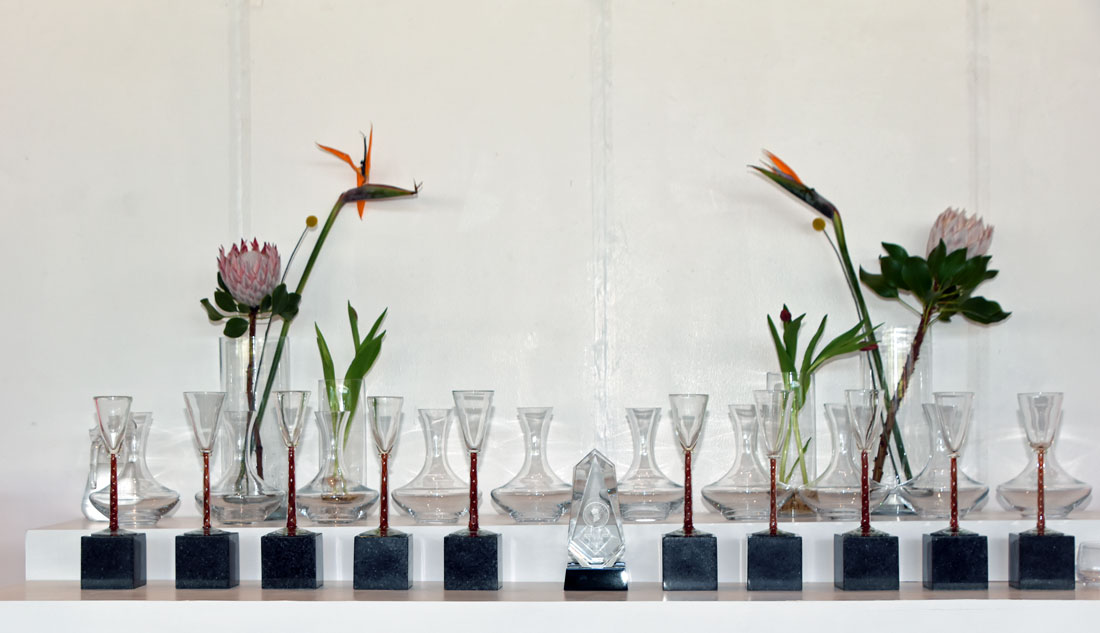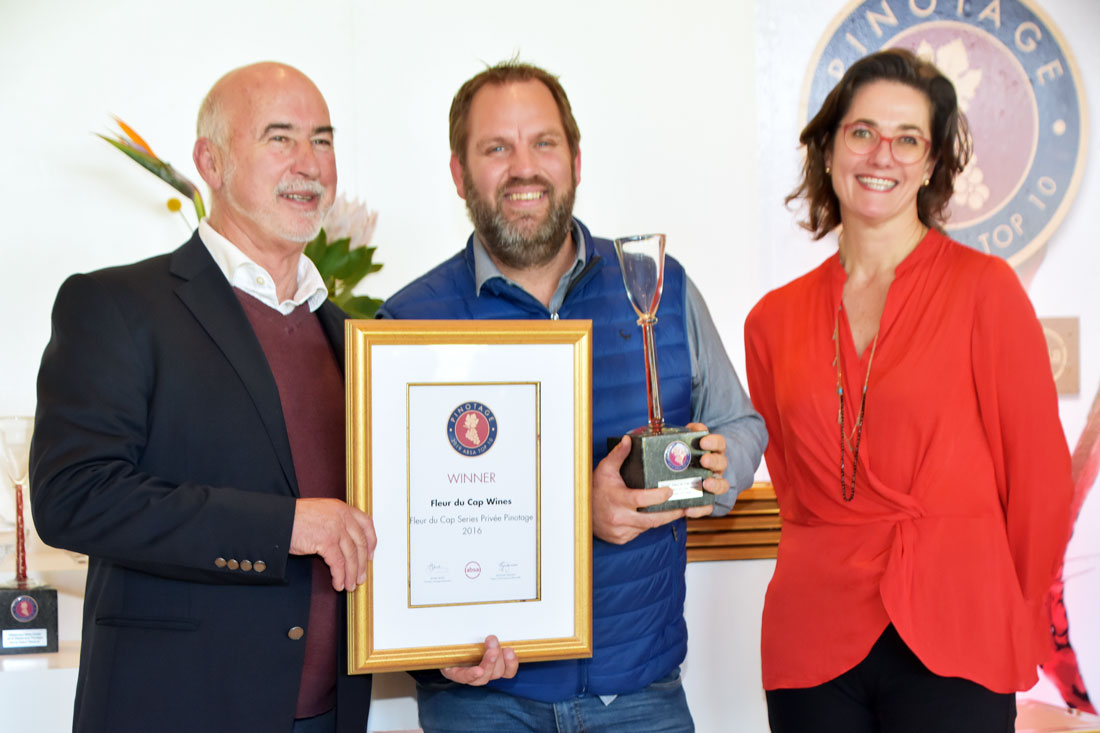An invitation to taste a range of current and vintage wines at Kanonkop was rapidly accepted. A rare occurrence, we so enjoyed our last tasting there and we were eager to repeat the experience. This was to be followed by a light lunch and that is always a special tradition at Kanonkop.
This is a range of the bottle sizes available: from Right to Left:
30 L – Melchizedek or Midas: equivalent of 40 Standard bottles
15 L – Nebuchadnezzar: equivalent of 20 Standard bottles
12 L – Balthazar or Belshazzar: equivalent of 16 Standard bottles
9 L – Salmanazar: equivalent of 12 Standard bottles
6 L – Methuselah: equivalent of 8 Standard bottles
3 L – Jeroboam or Double Magnum: equivalent of 4 Standard bottles
1.5 L – Magnum: equivalent of 2 Standard bottles
0.75 L – Standard: the common bottle size
A line up of some of the wines we were to taste
In the winery
The tasting sheet. We began with a glass of the Kanonkop Kadette Pinotage Rosé 2019, which has a lovely perfumed nose, red berry fruit and is very refreshing
Emil Joubert PRO gave us a brief history of the farm. Paul Sauer inherited a portion of his mother's farm Uitkyk in 1929 - it was a bare patch of 129 hectares with some orchards. They first grew fruit, but then changed to vines which were deemed more profitable. The estate is now in the care of the fourth generation of owners, currently brothers Johan and Paul Krige. Danie Rousseau planted the first Pinotage vines in 1943. In 1973, 1800 tons were delivered in bulk to Stellenbosch Farmers Winery. Jan Boland Coetzee, the first winemaker, started bottling small quantities of the wines called Springbok Wine and this continued for 12 to 14 years. The bulk wines then went into Chateau Libertas and Oude Libertas. In the 1980s, queues at their stands at wine shows were the longest so, in 1986, they left SFW and went on to make their own Estate Wines. They have never looked back. Beyers Truter, who was the winemaker, began to focus on red wine making and status was built. Their premium brand Paul Sauer was released for the first time in 1981
Current Cellarmaster Abrie Beeslaar was appointed by Beyers Truter in January 2002. The premium wines were selling out every year, so they decided to expand with another brand called Kadette into supermarkets and growth took off. The change of approach allowed them to manage stocks. The Kadette grapes come from Overgaauw and are machine harvested. Production of Kadette wine has reached 1.8 million bottles this year and is growing. Is it a nod to Mouton Rothschild's Cadet which also has superb sales in the same marketplace?
Site, People, Soil is the motto of Kanonkop
We tasted in the private upstairs tasting room
Erica Crawford of Love Block wines in New Zealand was visiting Cape Town
We tasted two vintages of the Kanonkop Kadette Cape Blend. The 2017 has good concentrated berry fruit and incense wood, long flavours and coffee wood on the end. The 2010 was similar on the nose with hints of rose and a bit more restrained on the palate. Then two Kanonkop Kadette Pinotages: the 2017 has richness of cherry and ripe berries, fresh fruit, grippy tannins and still youth. The 2013 has smoke, cassis, incense wood, some elegance and lovely fruit and length. A little chalky tannin, but a finish of delicious black cherry fruit
Next two vintages of the Kanonkop Pinotage: 2017 has richness, perfume, cassis, cherry and incense wood. Freshness and grip on the palate with youthful tension, chalk and it is waiting to come to the fore. Spent 19 months in 80% new oak, (98% French). Will be available for laying down at the end of this year, one to keep. The 2010 Kanonkop Pinotage was superb on the nose with rhubarb and raspberry pie notes, dry chalk, and sweet fruit, the wine is in balance with wood, fruit, alcohol and tannin. Lucky if you have some
The 2015 Kanonkop 2015 Cabernet Sauvignon (for release in October this year) has toffee apple on the nose, good cassis and rhubarb. It keeps changing on the nose and palate. Lovely fruit, then grippy tannins overtake. Wood smoke on the end with rose talcum, raspberry and strawberry fruit. It still needs time. One to watch. The Kanonkop 1997 Cabernet Sauvignon has sandalwood, salt, cassis and violets on the attractive nose. Lovely intense cassis fruit, some fruit acidity, soft chalk on the cheek remains, with dark wood on the end. A delight to taste
The Kanonkop 2016 Paul Sauer which was released in July this year, has an interesting nose of wood, perfume, cassis fruit, with spice and guava notes. Good fruit all though the chalky tannins overtake still. Needs time. Our second best wine of the tasting was the Kanonkop 1995 Paul Sauer, a much lauded and awarded wine, deservedly so. Complex nose, incense wood, sandalwood overtones and there is some saline minerality. Juicy cherry and raspberry fruit with great length, with tobacco and good tannins. 15% Cabernet Franc. This wine has years yet to go. 18.5/20 Then came the Kanonkop Black Label Pinotage 2017. Would that all pinotages could reach these heights. Spicy and pretty with incense wood, cherry and marmite, with sophistication and style. Lush sweet cherry, plum, berry fruit, just right. Soft chalky tannins. It sold out in 3 hours. We scored it 19/20. R1850 per bottle from the farm
Thank you Kanonkop, such a great opportunity to taste younger wines with older vintages to see what their potential is. They won't cut corners; they want to make better wine, not more wine. And of the same quality or better every year. The top wines are hand picked, sorted and punch down takes place in open fermentation tanks, then into older barrels. Only Kadette wines have an automatic punch down machine. Riper picking has increased alcohol, so this needs good management. 8 different vineyards from 660 66 year old bush vines. Structure and elegance comes from the South facing vineyards. The Cabernet grows on deconstructed granite and they don't pick overripe as they want the classic flavours, elegance with green pepper and greenness
Our two efficient pourers Diedre Taylor, the Marketing Manager
and Heidi Kritzinger who manages in-house sales
Journalist Fiona MacDonald and Judy Brower of Wine.co.za chatting with owner Johan Krige
Time for lunch and Kanonkop always do their famous snoek braai. This is one huge snoek
Onto the open fire, where is it basted constantly
On goes the lemony basting liquid, and it takes two to turn each grid over. The fish does not need much time and stays flavourful and moist
A good choice to go with the lunch
Lovely salads and there were sweet potatoes done in the traditional style
Outstanding farm bread and butter and grape jam - very traditional as a starter at a braai meal in South Africa. Thankfully, no pips in the jam
We assembled outside and were able to continue tasting the wines from upstairs
Abrie Beeslaar explaining to Anel Grobler, Alan Mullins and Lynne
Mrs Krige, the master chef! She served us our fish
Lots to enjoy
The sweet farm dog, hoping for dropped morsels
Admiring the wine in the vinoteque on our way out and home
All content © John & Lynne Ford, Adamastor & Bacchus
We assemble outside and were able to continue tasting the wines from upstairs
Abrie Beeslaar explaining to Anel Grobbler, Alan Mullins and Lynne
The master chef! She served us our fish
Lots to enjoy
The sweet farm dog, hoping for dropped morsels
Admiring the wine in the vinoteque on our way out and home












































































